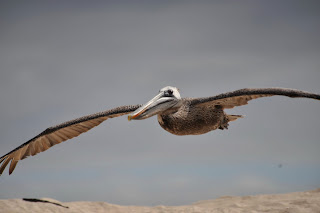


After a day flying from one side to the other of South America, one day battling with altitude sickness and one where we had a bad adventure (watch this space for more on this subject!), we found ourselves on another flight to the Galapagos Islands. Now, this has to be one of the most memorable and unique places on earth, especially for a wildlife photographer such as Nick. I'm sure everybody has heard about the Galapagos in relation to Charles Darwin and his book The Origin of Species, so rather than boring you with historical details I will go straight to talking about our experience there.
I knew Galapagos were famous for the abundant wildlife, and for the fact that some animals found there are not found anywhere else on earth. But nothing could prepare me to what we were going to find. As soon as we got off the plane and were ferried to the dock, we saw three sea lions snoozing on a bench, a couple of marine iguanas wandering around and blue footed boobies divebombing in the distance. And we hadn't boarded the boat yet! The best way to see the Galapagos is on a cruise, as the islands are quite far from one to the other. One of the features which makes the archipelago remarkable is the fact that each island is unique, both in landscape and wildlife. We opted for a eight night cruise, which allowed us to see all the island in the eastern part of the archipelago.
The boat, MV Darwin, was small and compact, allowing us to spend time with the rest of the guests and the crew. The guide Maria was a marine biologist who had over 25 years experience as a guide in the Galapagos, and even had a PhD on the behaviour of sea lions. We couldn't possibly hope for a better guide, both in terms of knowledge and friendliness. The rest of the guests were mainly Australian and Kiwi, with the exception of an American and a Swiss. Wehad in common the love for wildlife and the enthusiasm of discovering one of the most exciting places on Earth. We spent 8 days swimming, snorkelling and visiting the islands, each time finding something different around the corner. I didn't expect snorkelling to be such a big part of a Galapagos experience; every day we snorkelled at least twice, playing with sea lions was unforgettable. Sea lions are abundant throughout the archipelago, both above and under water. they are beautiful and curious creatures, who do not fear approaching humans and swimming around them. I did a forward roll and a backflip underwater, and they kept copying me. Bonding with animals in their natural habitat filled me with joy.
Although we swam with dozens of sea lions, we had no luck in finding sea turtles for the first few days, until one morning Maria woke us up at 6 to go snorkelling. Seeing turtles underwater was my highlight of the trip. They are enormous, over a metre in length. I was able to get closee enough to look at one in the eyes; they seemed so ancient to me. It made me think of the relationship between man and environment in the Galapagos, how humans should tread lightly in this fragile ecosystem which supported the development of wildlife for millions of years.
The Galapagos are as amazing underwater as they are above. the islands are all different, from Rabida with its red beaches to Santiago which offers fields of solidified lava. As a general rule, I found the southern islands to be have more abundant wildlife, and the northern islands to have better landscape and snorkelling. On our last day we even saw 5 white tipped sharks! Birds and reptiles are another highlight of the Galapagos; we saw thousands of blue-footed boobies and fregate birds with their characteristic red puffed neck used to attract females. We were able to see marine iguanas underwater and land iguanas on the beaches; but the most breathtaking for me was the sight of giant tortoises. We found them grazing in a field, in the highlands of Santa Cruz island. I felt minuscule and ephemeral next to this timeless creatures. If sea turtles were ancient, giant tortoises seemed eternal.









No comments:
Post a Comment